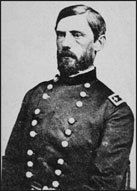Colonial Wars |
American Wars |
Link To This Page — Contact Us —
Major General John F. Reynolds
 |
| NAME |
| Reynolds, John Fulton |
| BORN |
| September 20, 1820 Lancaster, Pennsylvania |
| DIED |
| July 1, 1863 Gettysburg, Pennsylvania |
| ARMY |
| Union |
In the Mexican War, Reynolds was awarded 2 brevet promotions,, to captain for actions at Monterrey and to major for actions at Buena Vista. Afterwards, he served in garrison duty, Indian fighting, and the Utah Expedition. He was appointed as an instructor and Commandant of Cadets at West Point. While in these academic roles, between 1855-61, he was formally assigned as a captain in the 3rd U.S. Artillery.
At the start of the Civil War, Reynolds was assigned a Lieutenant Colonel of the 14th U.S. Infantry. He was promoted to Brigadier General about a month after 1st Bull Run, and was given command of a brigade of Pennsylvania Reserves. That unit played an important role in the Peninsula Campaign. The day after Gaines' Mill, he became separated from his troops and went to sleep. Shortly after this, he was captured by Confederates and brought to Major Gen. D.H. Hill. Hill was an old friend from before the war. He was sent to Libby Prison and was exchanged on August 13, 1862. Two weeks after his release, he command the Pennsylvania Reserves Division in the Union defeat at 2nd Bull Run.
At the request of Pennsylvania's Governor Andrew G. Curtin, Reynolds was detached and assigned to organize the state militia during the panic occasioned by Gen. Robert E. Lee's invasion of Maryland, the Maryland Campaign. Because of this, he missed the battle of Antietam but returned to command the I Corps at Fredericksburg where one of his divisions, under Major Gen. George G. Meade, made the only breach in the Confederate lines. His corps played only a minor role at Chancellorsville, where the Union suffered a humiliating defeat under Major Gen. Joseph Hooker. Reynolds became disgusted with Hooker's leadership ability.
After accepting Hooker's resignation, President Abraham Lincoln considered Reynolds as the next commander of the Army of the Potomac. He refused the command when his demands of complete autonomy from political interference were denied. Meade was promoted in his place and he was put in command of the III Corps. Some have speculated that had he accepted the command, the outcome at Gettysburg may have been very different.
At Gettysburg, on the morning of July 1, Brigadier Gen. John Buford's cavalry division was fighting west of the town. He called upon the nearest infantry, Reynolds' I Corps, to help. Reynolds that day was commanding the "left wing" of the Army of the Potomac, with operational control over the I, II, III, and XI Corps. He arrived with the 1st Division and accompanied some of its soldiers into the fighting at McPherson's Woods. He hurriedly shuffled his leading infantry units forward to replace the Union cavalry, who were fighting Confederate infantry. While entering the woods, he turned in his saddle to look for more troops. He was shot in the back of the neck and fell off his horse. He died almost instantly. He was rushed to an ambulance and, as the ambulance passed by the troops, it cast a mood of sadness over the regiments. Command passed to his senior division commander, Major Gen. Abner Doubleday. He was immediately transported from Gettysburg to Lancaster, Pennsylvania, where he is buried.
The loss of Reynolds was keenly felt by the army. He was loved by his men and respected by his peers. He was considered one of the best corps commanders.
Promotions:
- Lieutenant Colonel - May 14, 1861
- Brigadier General USV- August 20, 1861
- Major General USV- November 29, 1862
Major Commands:
- lst Brigade, McCall's Division, Army of the Potomac (October 3, 186 1-March 13, 1862)
- 1st Brigade, 2nd Division, I Corps, Army of the Potomac (March 13-April 4, 1862)
- 1st Brigade, 2nd Division, Department of the Rappahannock (April 4-June 12, 1862)
- 1st Brigade, 3rd Division, V Corps, Army of the Potomac (June 18-27, 1862)
- 3rd Division, III Corps, Army of Virginia (August 26-September 12, 1862)
- Pennsylvania Militia (September 13-ca. 29, 1862)
- I Corps, Army of the Potomac (September 29, 1862-January 2, 1863, January 4-March 1, and March 9-July 1, 1863)
- Left Wing (I, III, and XI Corps), Army of the Potomac (June 30-July 1, 1863)
